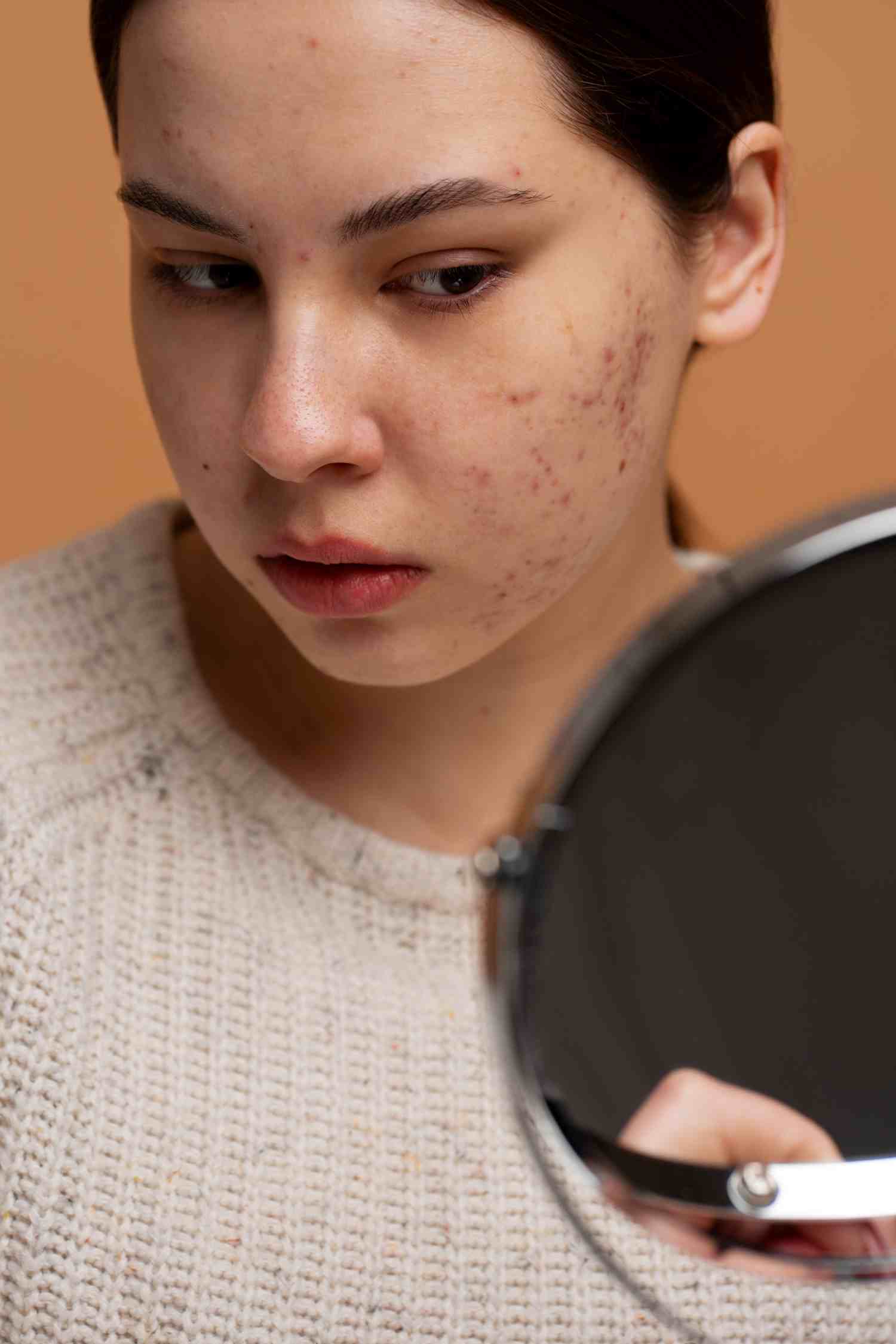
Dealing with acne scars can be a source of frustration and self-consciousness for many individuals. While there are various over-the-counter products and home remedies available, it's important to note that these may not always be effective and can even cause further damage.
Types of Acne Scars
1. Ice-pick scars are a type of atrophic acne scar that results from severe acne. These scars are characterized by deep, narrow holes that resemble the marks left by an ice pick. They are typically small in size but can be quite deep and noticeable, giving the skin a pitted appearance. Ice-pick scars are caused by the loss of tissue beneath the skin due to inflammatory acne lesions, which result in the formation of these deep, narrow scars.
2. Boxcar scars are a type of acne scar characterized by wider, U-shaped depressions in the skin with well-defined edges. They are typically caused by inflammatory acne, which can break down collagen in the skin. Boxcar scars are more commonly found on the cheeks and temples. These scars are often a result of the body's inflammatory response to acne lesions. When the skin tissue is destroyed during the inflammatory process, it can leave behind these depressions in the skin, resulting in boxcar scars.
3. Rolling scars are a type of acne scar characterized by wide depressions with sloping edges, which create a wave-like appearance on the skin. These scars are often the result of long-term inflammatory acne. The inflammatory response damages the collagen in the skin, leading to a loss of tissue and the formation of these depressed areas. Rolling scars can make the skin appear uneven and can have a significant impact on a person's self-esteem.
4. Atrophic scars are flat, thin scars that result from the healing of acne lesions. They are typically small and shallow, and they appear on the skin as smooth depressions.
5. Hypertrophic scars are raised and red scars form from excess collagen during the healing process. They are more commonly found on the chest, back, and shoulders. They can be itchy and painful, causing discomfort for individuals who have them.Hypertrophic scars are often associated with skin trauma or injury, such as burns, surgery, or severe acne. When the body produces an excess amount of collagen during the healing process, it can lead to the development of these raised and often uncomfortable scars.
6. Keloid scars are a type of raised scar that extends beyond the original wound. An overgrowth of scar tissue characterizes these scars and can be itchy, tender, or even painful.They are more common in individuals with darker skin tones. Keloids form as a result of an excessive response to tissue injury or irritation. They can develop after surgery, acne scars, burns, or even minor scratches. Unlike normal scars, keloids do not regress over time and can continue to grow indefinitely.
7. Hyperpigmentation refers to the darkening of skin surrounding scars.The enhanced melanin generation that occurs throughout the skin's healing process is the cause of this darkening.The substance that gives our skin its color is called melanin. The body attempts to defend the wounded region of the skin by producing more melanin when it is harmed, which causes the skin to darken.
Scars may become more obvious due to hyperpigmentation, particularly in those with lighter skin tones. Hyperpigmentation can take a long time to go away, and in certain situations, therapy may be necessary before it does.The degree of hyperpigmentation can vary depending on a number of factors, including skin type, sun exposure,and the depth of the initial incision.
It's crucial to understand that these types of scarring can significantly impact a person's self-esteem and confidence.
1. Boosting Collagen:
Energy-based devices (Radiofrequency/Lasers): These devices deliver controlled energy deep into the skin, stimulating the production of collagen,a protein that provides structure elasticity.Increased collagen helps plump up scar tissue, making it less noticeable.
2. Exfoliation for Smoother Skin:
Chemical Peels:A chemical solution is applied to the skin,causing the top layer to peel off.This reveals smoother, less-scarred skin underneath. Chemical peels are most effective for mild, shallow scars.
3. Retinoid Creams:
Retinoid creams:Derived from vitamin A, these creams accelerate cell turnover, promoting the growth of new,healthier skin cells.This can improve the overall texture and reduce the appearance of shallow scars.
4. Micro-needling:
Micro needling: A device with tiny needles creates controlled punctures in the skin.This triggers the body's natural healing response, leading to increased collagen production and improved scar texture.
5. Platelet-rich plasma (PRP) therapy involves using a patient's blood to promote healing and tissue regeneration.The process begins by drawing a small amount of blood from the patient,which is then placed into a centrifuge to separate the platelet-rich plasma from the rest of the blood components. The resulting PRP is then injected into the scarred area, often in combination with fat grafts for deeper scars.
PRP contains growth factors and other proteins that are essential for tissue repair and regeneration. When injected into the affected area, PRP promotes the formation of new collagen and blood vessels,ultimately improving the appearance of rolling scars. The growth factors in PRP also stimulate the body's natural healing process, leading to tissue rejuvenation and enhanced skin texture.

6. Taming Inflammation:
Steroid Injections: Steroid injections are used to reduce inflammation in raised or thickened scars (hypertrophic/keloid scars).This helps flatten the scar and improve its overall appearance.
7. Surgical Solutions:
Surgical removal: This option is suitable for acne scars surgery in Delhi.This approach provides the most dramatic improvement but comes with potential risks like scarring itself.
8. Laser Power for Deeper Scars:
Ablative lasers: These lasers remove the top layers of skin with greater precision than chemical peels. They are effective for deeper scars but require longer healing times due to the larger area treated.
9. Fading Dark Spots:
Hydroquinone creams: These creams help lighten areas of hyperpigmentation (darkening) around scars. They work by inhibiting the production of melanin, the pigment that gives skin its color.
Sunscreen is essential for preventing sun exposure, which can worsen hyperpigmentation. Consistent sunscreen use is crucial for maintaining the results of any scar treatment.
10. Glycolic Acid:
Glycolic acid creams: These creams offer a milder form of exfoliation compared to chemical peels. They can help remove the top layer of skin cells with hyperpigmentation, leading to a more even skin tone.
To reduce the risk of developing acne scars promote overall skin health, it's essential to maintain a healthy skincare routine. Here are some detailed tips on how to stay healthy:
1. Gentle Cleansing:
Use a mild, non-abrasive cleanser to wash your face twice a day. Avoid harsh scrubbing, as it can irritate the skin and worsen acne.
2. Non-Comedogenic Products:
Choose skincare and makeup products labeled as non-comedogenic, meaning they won't clog pores.
Look for oil-free and water-based formulations to prevent pore blockage.
3. Balanced Diet:
Incorporate a variety of fruits, vegetables, whole grains into your diet to provide essential nutrients for skin health.
Foods rich in antioxidants, such as berries, spinach, and nuts, can help combat inflammation and support skin regeneration.
4. Hydration:
Drink an adequate amount of water daily to keep the skin hydrated maintain its elasticity. Limit consumption of sugary and caffeinated beverages, as they can contribute to skin dehydration.
5. Sun Protection:
Apply a broad-spectrum sunscreen with at least SPF 30 daily, even on overcast days. Wear protective clothing, such as wide-brimmed hats sunglasses, when spending extended time outdoors.
6. Hands-Off Approach:
Refrain from picking, squeezing, or popping acne lesions, as this can lead to inflammation scarring. Gently cleanse the skin and apply spot treatments instead of touching or manipulating active acne.
7. Stress Management:
Practice stress-reducing activities, such as meditation, yoga, or deep breathing exercises, to minimize the impact of stress on skin health. Adequate sleep and regular physical activity can also contribute to overall stress reduction and improved skin condition.
There are lots of reasons contributing to the reason of acne scars. Some of the possible reasons are injury, infection, or acne. The scenario creates visibility of scars on the face which directly impact the person's aesthetic. Most of the scars are left with wound scabs and slowly reduce over time. To get rid of the scar and enhance the aesthetic, there are some cosmetic procedures used for acne scar removal in Delhi. However, the cosmetic procedure also depends on the types and extent of scars. Here’s the possible scar removal surgery in Delhi.
1. Laser Scar Removal: It is one of the most common as well as quick and safe procedures for reducing scars. The treatment of laser scar removal is especially useful for complex acne scars that are quite difficult to remove. The procedure uses the evaporation technique where a laser is used to evaporate the outer skin layer and promote the growth of new tissues from underneath.
2. Dermal Fillers: The technique of dermal fillers is used to reduce the deep pits caused by long scars such as acne marks, pockmarks, or injury marks. The treatment of dermal fillers use hyaluronic acid and calcium hydroxylapatite which is injected either on the skin or close to the acne marks. The injected chemical compounds help in skin rejuvenation and stimulate the skin collagen to the speed up the acne scars healing. However, the procedure may take a longer time but is safe in every aspect.
3. Microdermabrasion: It is one of the most advanced and popular procedures that effectively treat acne scars. The procedure of microdermabrasion acts on the topmost layer of the skin and abrades it. However, the technique is effective in treating the lighter scars that are not deeply attached to the skin root. If the scars are too old, they damage the skin roots. So, for the best result, it is not advised to go with microdermabrasion. The procedure is only effective in reducing the pigmentation caused by acne scars.
4. Dermabrasion: Dermabrasion is all about polishing the rough and thick scar tissues. The method of Dermabrasion is used to treat old acne scars and the formation of keloids. The treatment technique uses a tool called abrasion to resurface the skin and make it smoother. The method is especially effective when it is taken with other scar removal methods.
5. Punch Excision Skin-grafting: Punch Excision Skin-grafting is effective in getting rid of the deeper acne scars and pits caused by pockmarks. However, the surgical method is a little painful as it combines cutting the edge and top of the scar and then the skin is grafted over the scars.
To get the best acne scar treatment in Delhi, you can fix an appointment or connect with Dr Anup Dhir, to ensure the best possible outcomes.
If you're seeking acne scar treatment in Delhi for optimal results, rest assured that Dr. Anup Dhir has the expertise you need. With his guidance and improvements, you can embark on a journey towards the best possible outcome. Book a consultation with Dr. Anup Dhir today to start your journey towards optimal results and feel secure and well-guided.
Leave a request to connect to Dr. Anup Dhir for an Appointment.